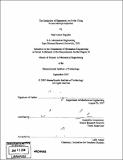The reduction of supersonic jet noise using pulsed microjet injection
Author(s)
Ragaller, Paul Aaron
DownloadFull printable version (11.02Mb)
Other Contributors
Massachusetts Institute of Technology. Dept. of Mechanical Engineering.
Advisor
Anuradha Annaswamy.
Terms of use
Metadata
Show full item recordAbstract
This thesis is concerned with the active control of supersonic jet noise using pulsed microjet injection at the nozzle exit. Experimental investigations were carried out using this control method on an ideally expanded Mach 1.8 jet operating at 900, 1300 and 1700'F. Six Bosch fuel injectors were modified and mounted on a toroidal manifold around a Mach 1.8 nozzle. Noise data were collected from the jet at baseline condition, which refers to the uncontrolled case. The injectors were fired at pressures of 400 and 800 psig, using water, at frequencies of 1, 5 and 10 Hz and at duty cycles of 50 and 75%. For comparison, acoustic data were also collected from the jet while the microjets were injecting steadily at a constant pressure. The results led to the following two conclusions: for injection at a given mass flow rate, noise reductions are higher with pulsed injection compared to the steady case, and for injection at a given pressure, the amount of noise reduction increases with duty cycle. In particular, for pulsing at a 50% duty cycle, pulsing achieves comparable noise reduction as compared to steady injection at all of the temperatures tested while using only 66% of the mass flow rate. The most dramatic result was achieved at 17000F for pulsing at a 75% duty cycle with an injection pressure of 800 psig. In this case, pulsing achieves 317% of the noise reduction as compared to steady injection (corresponding to 2.6 and 0.8 dB respectively) while using a comparable amount of water. Similar results were obtained at lower temperatures as well. At all operating points it was found that less water is used with pulsing to achieve a given noise reduction, and is realized at the cost of a higher injection pressure. Suggestions are provided as to how to determine the frequency and duty cycle required for maximum noise suppression with the least amount of water.
Description
Thesis (S.M.)--Massachusetts Institute of Technology, Dept. of Mechanical Engineering, 2007. Includes bibliographical references (leaf 99).
Date issued
2007Department
Massachusetts Institute of Technology. Department of Mechanical EngineeringPublisher
Massachusetts Institute of Technology
Keywords
Mechanical Engineering.